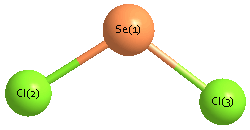Vibrational Frequencies calculated at MP2=FULL/daug-cc-pVTZ
| Mode Number |
Symmetry |
Frequency
(cm-1) |
Scaled Frequency
(cm-1) |
IR Intensities
(km mol-1) |
Raman Act
(Å4/u) |
Dep P |
Dep U |
|---|
| 1 |
A1 |
450 |
450 |
9.77 |
19.33 |
0.07 |
0.13 |
| 2 |
A1 |
167 |
167 |
0.67 |
4.60 |
0.60 |
0.75 |
| 3 |
B2 |
432 |
432 |
49.10 |
5.99 |
0.75 |
0.86 |
Unscaled Zero Point Vibrational Energy (zpe) 524.3 cm
-1
Scaled (by 1) Zero Point Vibrational Energy (zpe) 524.3 cm
-1
See section
III.C.1 List or set vibrational scaling factors
to change the scale factors used here.
See section
III.C.2
Calculate a vibrational scaling factor for a given set of molecules
to determine the least squares best scaling factor.
